Matthew E. Peters
OLMo: Accelerating the Science of Language Models
Feb 07, 2024
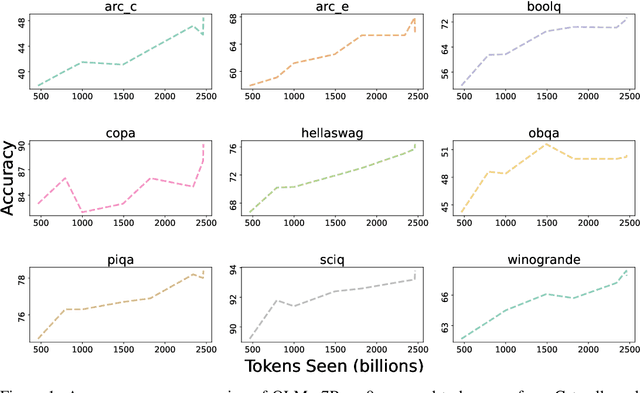
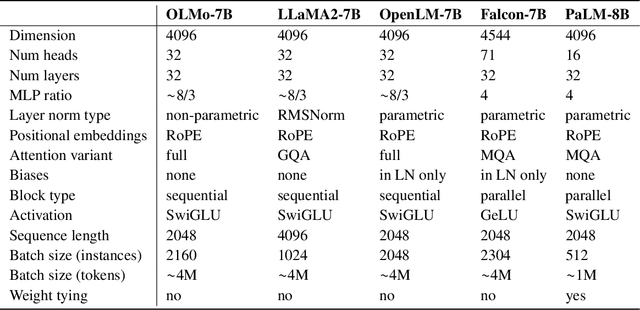
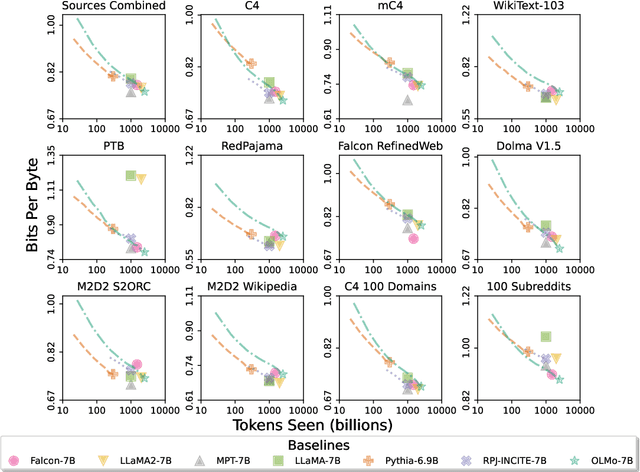
Abstract:Language models (LMs) have become ubiquitous in both NLP research and in commercial product offerings. As their commercial importance has surged, the most powerful models have become closed off, gated behind proprietary interfaces, with important details of their training data, architectures, and development undisclosed. Given the importance of these details in scientifically studying these models, including their biases and potential risks, we believe it is essential for the research community to have access to powerful, truly open LMs. To this end, this technical report details the first release of OLMo, a state-of-the-art, truly Open Language Model and its framework to build and study the science of language modeling. Unlike most prior efforts that have only released model weights and inference code, we release OLMo and the whole framework, including training data and training and evaluation code. We hope this release will empower and strengthen the open research community and inspire a new wave of innovation.
Dolma: an Open Corpus of Three Trillion Tokens for Language Model Pretraining Research
Jan 31, 2024



Abstract:Language models have become a critical technology to tackling a wide range of natural language processing tasks, yet many details about how the best-performing language models were developed are not reported. In particular, information about their pretraining corpora is seldom discussed: commercial language models rarely provide any information about their data; even open models rarely release datasets they are trained on, or an exact recipe to reproduce them. As a result, it is challenging to conduct certain threads of language modeling research, such as understanding how training data impacts model capabilities and shapes their limitations. To facilitate open research on language model pretraining, we release Dolma, a three trillion tokens English corpus, built from a diverse mixture of web content, scientific papers, code, public-domain books, social media, and encyclopedic materials. In addition, we open source our data curation toolkit to enable further experimentation and reproduction of our work. In this report, we document Dolma, including its design principles, details about its construction, and a summary of its contents. We interleave this report with analyses and experimental results from training language models on intermediate states of Dolma to share what we have learned about important data curation practices, including the role of content or quality filters, deduplication, and multi-source mixing. Dolma has been used to train OLMo, a state-of-the-art, open language model and framework designed to build and study the science of language modeling.
ACE: A fast, skillful learned global atmospheric model for climate prediction
Oct 03, 2023
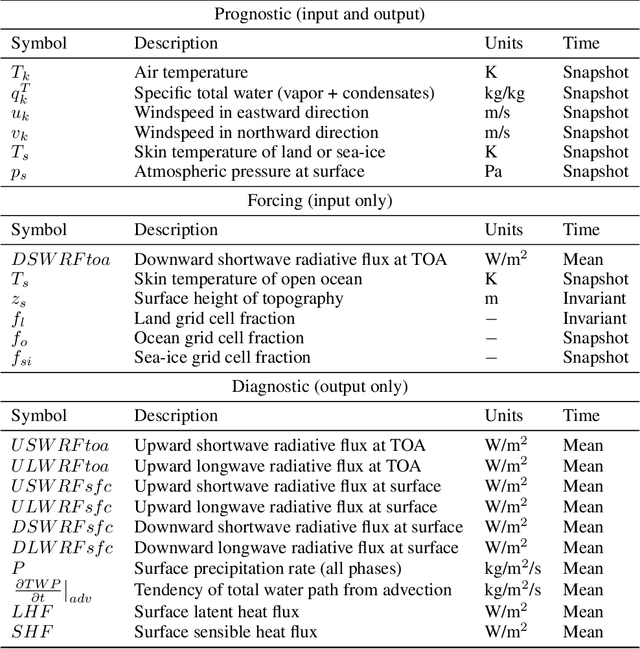


Abstract:Existing ML-based atmospheric models are not suitable for climate prediction, which requires long-term stability and physical consistency. We present ACE (AI2 Climate Emulator), a 200M-parameter, autoregressive machine learning emulator of an existing comprehensive 100-km resolution global atmospheric model. The formulation of ACE allows evaluation of physical laws such as the conservation of mass and moisture. The emulator is stable for 10 years, nearly conserves column moisture without explicit constraints and faithfully reproduces the reference model's climate, outperforming a challenging baseline on over 80% of tracked variables. ACE requires nearly 100x less wall clock time and is 100x more energy efficient than the reference model using typically available resources.
Efficiency Pentathlon: A Standardized Arena for Efficiency Evaluation
Jul 19, 2023Abstract:Rising computational demands of modern natural language processing (NLP) systems have increased the barrier to entry for cutting-edge research while posing serious environmental concerns. Yet, progress on model efficiency has been impeded by practical challenges in model evaluation and comparison. For example, hardware is challenging to control due to disparate levels of accessibility across different institutions. Moreover, improvements in metrics such as FLOPs often fail to translate to progress in real-world applications. In response, we introduce Pentathlon, a benchmark for holistic and realistic evaluation of model efficiency. Pentathlon focuses on inference, which accounts for a majority of the compute in a model's lifecycle. It offers a strictly-controlled hardware platform, and is designed to mirror real-world applications scenarios. It incorporates a suite of metrics that target different aspects of efficiency, including latency, throughput, memory overhead, and energy consumption. Pentathlon also comes with a software library that can be seamlessly integrated into any codebase and enable evaluation. As a standardized and centralized evaluation platform, Pentathlon can drastically reduce the workload to make fair and reproducible efficiency comparisons. While initially focused on natural language processing (NLP) models, Pentathlon is designed to allow flexible extension to other fields. We envision Pentathlon will stimulate algorithmic innovations in building efficient models, and foster an increased awareness of the social and environmental implications in the development of future-generation NLP models.
Peek Across: Improving Multi-Document Modeling via Cross-Document Question-Answering
May 24, 2023Abstract:The integration of multi-document pre-training objectives into language models has resulted in remarkable improvements in multi-document downstream tasks. In this work, we propose extending this idea by pre-training a generic multi-document model from a novel cross-document question answering pre-training objective. To that end, given a set (or cluster) of topically-related documents, we systematically generate semantically-oriented questions from a salient sentence in one document and challenge the model, during pre-training, to answer these questions while "peeking" into other topically-related documents. In a similar manner, the model is also challenged to recover the sentence from which the question was generated, again while leveraging cross-document information. This novel multi-document QA formulation directs the model to better recover cross-text informational relations, and introduces a natural augmentation that artificially increases the pre-training data. Further, unlike prior multi-document models that focus on either classification or summarization tasks, our pre-training objective formulation enables the model to perform tasks that involve both short text generation (e.g., QA) and long text generation (e.g., summarization). Following this scheme, we pre-train our model -- termed QAmden -- and evaluate its performance across several multi-document tasks, including multi-document QA, summarization, and query-focused summarization, yielding improvements of up to 7%, and significantly outperforms zero-shot GPT-3.5 and GPT-4.
TESS: Text-to-Text Self-Conditioned Simplex Diffusion
May 15, 2023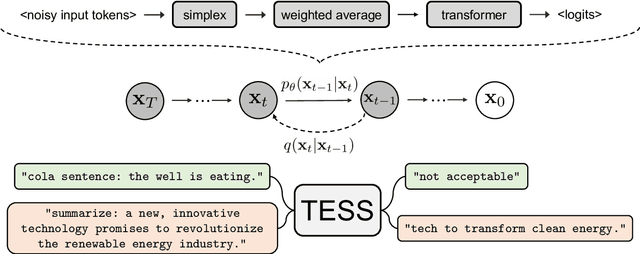
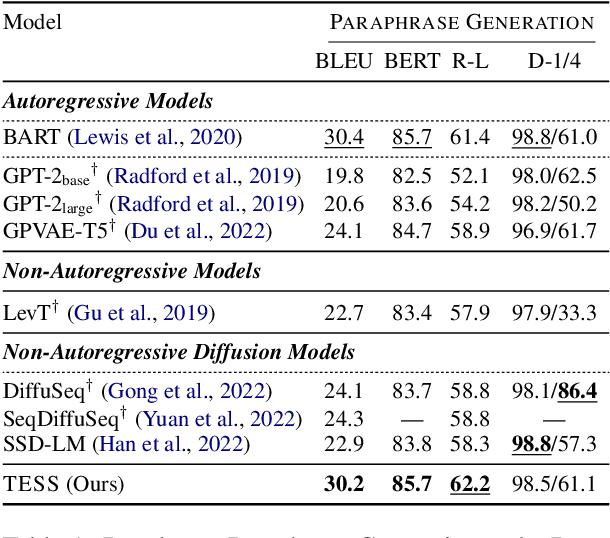

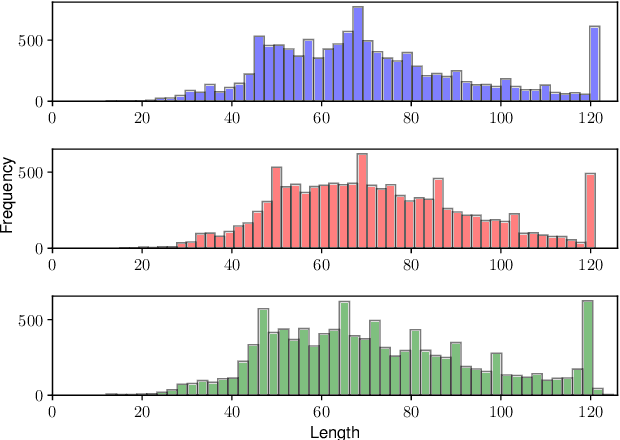
Abstract:Diffusion models have emerged as a powerful paradigm for generation, obtaining strong performance in various domains with continuous-valued inputs. Despite the promises of fully non-autoregressive text generation, applying diffusion models to natural language remains challenging due to its discrete nature. In this work, we propose Text-to-text Self-conditioned Simplex Diffusion (TESS), a text diffusion model that is fully non-autoregressive, employs a new form of self-conditioning, and applies the diffusion process on the logit simplex space rather than the typical learned embedding space. Through extensive experiments on natural language understanding and generation tasks including summarization, text simplification, paraphrase generation, and question generation, we demonstrate that TESS outperforms state-of-the-art non-autoregressive models and is competitive with pretrained autoregressive sequence-to-sequence models.
AdapterSoup: Weight Averaging to Improve Generalization of Pretrained Language Models
Feb 14, 2023



Abstract:Pretrained language models (PLMs) are trained on massive corpora, but often need to specialize to specific domains. A parameter-efficient adaptation method suggests training an adapter for each domain on the task of language modeling. This leads to good in-domain scores but can be impractical for domain- or resource-restricted settings. A solution is to use a related-domain adapter for the novel domain at test time. In this paper, we introduce AdapterSoup, an approach that performs weight-space averaging of adapters trained on different domains. Our approach is embarrassingly parallel: first, we train a set of domain-specific adapters; then, for each novel domain, we determine which adapters should be averaged at test time. We present extensive experiments showing that AdapterSoup consistently improves performance to new domains without extra training. We also explore weight averaging of adapters trained on the same domain with different hyper-parameters, and show that it preserves the performance of a PLM on new domains while obtaining strong in-domain results. We explore various approaches for choosing which adapters to combine, such as text clustering and semantic similarity. We find that using clustering leads to the most competitive results on novel domains.
Does Self-Rationalization Improve Robustness to Spurious Correlations?
Oct 24, 2022



Abstract:Rationalization is fundamental to human reasoning and learning. NLP models trained to produce rationales along with predictions, called self-rationalization models, have been investigated for their interpretability and utility to end-users. However, the extent to which training with human-written rationales facilitates learning remains an under-explored question. We ask whether training models to self-rationalize can aid in their learning to solve tasks for the right reasons. Specifically, we evaluate how training self-rationalization models with free-text rationales affects robustness to spurious correlations in fine-tuned encoder-decoder and decoder-only models of six different sizes. We evaluate robustness to spurious correlations by measuring performance on 1) manually annotated challenge datasets and 2) subsets of original test sets where reliance on spurious correlations would fail to produce correct answers. We find that while self-rationalization can improve robustness to spurious correlations in low-resource settings, it tends to hurt robustness in higher-resource settings. Furthermore, these effects depend on model family and size, as well as on rationale content. Together, our results suggest that explainability can come at the cost of robustness; thus, appropriate care should be taken when training self-rationalizing models with the goal of creating more trustworthy models.
Attentional Mixtures of Soft Prompt Tuning for Parameter-efficient Multi-task Knowledge Sharing
May 24, 2022



Abstract:This work introduces ATTEMPT (Attentional Mixture of Prompt Tuning), a new modular, multi-task, and parameter-efficient language model (LM) tuning approach that combines knowledge transferred across different tasks via a mixture of soft prompts while keeping original LM unchanged. ATTEMPT interpolates a set of prompts trained on large-scale source tasks and a newly initialized target task prompt using instance-wise attention computed by a lightweight sub-network trained on multiple target tasks. ATTEMPT is parameter-efficient (e.g., updates 1,600 times fewer parameters than fine-tuning) and enables multi-task learning and flexible extensions; importantly, it is also more interpretable because it demonstrates which source tasks affect the final model decision on target tasks. Experimental results across 17 diverse datasets show that ATTEMPT improves prompt tuning by up to a 22% absolute performance gain and outperforms or matches fully fine-tuned or other parameter-efficient tuning approaches that use over ten times more parameters.
Extracting Latent Steering Vectors from Pretrained Language Models
May 10, 2022



Abstract:Prior work on controllable text generation has focused on learning how to control language models through trainable decoding, smart-prompt design, or fine-tuning based on a desired objective. We hypothesize that the information needed to steer the model to generate a target sentence is already encoded within the model. Accordingly, we explore a different approach altogether: extracting latent vectors directly from pretrained language model decoders without fine-tuning. Experiments show that there exist steering vectors, which, when added to the hidden states of the language model, generate a target sentence nearly perfectly (> 99 BLEU) for English sentences from a variety of domains. We show that vector arithmetic can be used for unsupervised sentiment transfer on the Yelp sentiment benchmark, with performance comparable to models tailored to this task. We find that distances between steering vectors reflect sentence similarity when evaluated on a textual similarity benchmark (STS-B), outperforming pooled hidden states of models. Finally, we present an analysis of the intrinsic properties of the steering vectors. Taken together, our results suggest that frozen LMs can be effectively controlled through their latent steering space.
 Add to Chrome
Add to Chrome Add to Firefox
Add to Firefox Add to Edge
Add to Edge